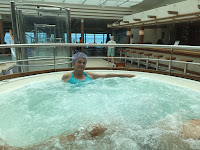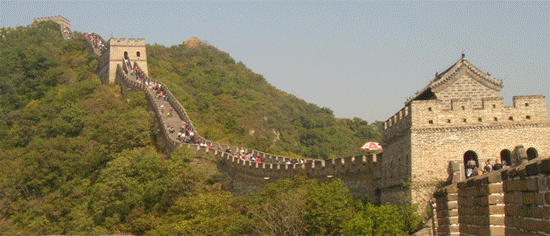The Majestic Princess is a new ship with some wonderful features. We were upgraded to a Deluxe Balcony Cabin towards the stern of the ship. Now, some always opt for mid-ship cabins with the expectation that there will be less ship movement than at the pointy or blunt ends; but I have to say the seas have been so calm that it is difficult to know one is on a ship at all. The trick that increases the possibility of an upgrade is not to request a particular cabin. If you ask for deck 9, cabin 9733, that is what you will get. If you ask for a class of cabin that is guaranteed, you may be ultimately upgraded, or not. Our cabin, as a ‘deluxe’, is marginally larger with a couch but has a balcony twice the usual size, which is M’s favourite feature since she devours books resplendent on deck chair in the sea air. If you enlarge picture four you will see a whale breaching.








On Deck 17 there are the usual swimming pools and spas where well-fed seals in costumes that have clearly shrunk in the salty air lounge lazily on deck chairs watching the midday movie on the big screen up by the funnels. One door on this deck leads into the gymnasium where numerous show-offs pump iron, ride bikes, row boats, or run tread-mills before heading off for a double helping of ice-cream. From the gym there is access to a an indoor swimming pool, spa and lounge area - very impressive under filtered skylight. This top deck also has a large tennis/basketball court, a number of small enclosed areas for table tennis that keep the ball inside rather than over the deck rail, and various deck games.




Deck 16 houses The Marketplace - a fancy name for the Buffet - where you can share tables with passengers for breakfast, lunch, and dinner if you do not want to dine in two of the restaurants. On this ship, you can choose to reserve tables for early or late dining or you can do as we do for ‘anytime dining’ which has worked quite well. In the restaurants you may choose to dine alone or to share a table. On most occasions we choose to share so we can hear all the complaints! No, it’s not that bad! We have met some interesting people, and that is one of the joys of cruising. But it is a very long walk to the restaurants from the stern to the bow!





There is a very large theatre that possibly seats a thousand guests and a variety of shows are presented every night in two sessions. The ship has its own singing and dancing company who perform two or three times over the voyage. Other presentations have included musicians, singers, comedians, and a mentalist - all very entertaining and usually keeping us up quite late. As we crossed the equator a ceremony was conducted around the pools to initiate new members who had never done that previously. They are covered in excess foodstuffs of various kinds and thrown in the pool by King Neptune. Trivia is conducted daily in one of the lounges and many are addicted to it.



















































